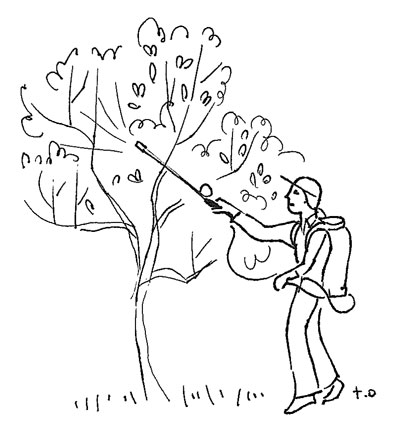 |
| Toki Oshima drawing |
By C. J. Walke
This is often the unasked question that arises when I deliver library presentations or teach hands-on workshops on growing organic tree fruit. I can see the look on people’s faces change when I mention the backpack sprayer, as if a dark storm cloud has shadowed their sunny afternoon. We choose organic methods to avoid synthetic chemicals on our food and broad spectrum, pervasive pesticides in our environment, most of which are applied via some type of spray mechanism, but it’s what you put in the tank that makes the sprayer evil. Or beneficial.
Although the spray tank can contain a concoction to deliver death and destruction, I prefer to view the sprayer as a vehicle for delivering nutrients and boosting health in the orchard or garden ecosystem by applying materials that are not easily slung with a shovel or dumped from a bag. Many nutrients and beneficial organisms come in liquid or granular form to be mixed with water and topically applied to the tree canopy and leaf surfaces. And yes, the occasional teaspoons of Bt (Bacillus thuringiensis) or spinosad get mixed in to keep the lepidopteran (moth or butterfly) larva and sawfly slugs in check, but that is only a fraction of the time spent with the sprayer on your back.
Foliar feeding can benefit all crops, when the proper materials are applied at the correct time. Plant leaves can absorb nutrients through minute pores between leaf cells, called transcuticular pores, as well as through stomata on the underside of leaves, which allow the flow of carbon dioxide, oxygen and water in and out of the leaf. When leaves absorb dissolved nutrients through their stomata, they can then translocate those nutrients to where they are needed within the plant. Research suggests that uptake of certain nutrients can be 10 times more efficient through leaves than roots.
It’s important to remember that long-term, stable fertility lies in the building of biologically rich soil – feed the soil, not the plant – but boosts of nutrients can be applied when plant needs are high. In addition to nutrients, beneficial microorganisms, such as effective microbes, can be added to the orchard ecosystem through a spray mixture. (See my articles “Life in the Phyllosphere” in the winter 2014-2015 MOF&G and “Building Health in the Orchard” in the fall 2014 MOF&G.)
In the orchard we can apply materials such as raw neem oil and hydrolyzed fish in the spring to give trees a boost of nutrients as they wake from their winter slumber and strive toward bloom; at the same time those materials provide food sources for our fungal allies, the mycorrhizae. In the summer we can apply calcium and silica in the form of comfrey and nettle teas to enhance fruit development and ripening, while strengthening the waxy cuticle of the fruit surface to reduce summer diseases, such as sooty blotch and fly speck. And in fall, we can come back to fish and oils to speed decomposition of scab-infected leaves and smother insect eggs or fungal spores waiting to winter over and induce infection or infestation come spring.
At markets I often see signs on stands that read “no spray,” “unsprayed” or “low spray” as a reassurance to customers that the crops being grown and the food products being offered have not been coated with nasty chemicals before reaching our plates. Of course this is of valid concern, but for absolute assurance, the MOFGA-certified organic label is the best choice. I often wonder if that unsprayed apple would be a little crisper or the flavor slightly sweeter if it had absorbed foliar foods or had the company of beneficial microbes. Personally I am more concerned about what could be shot from a spreader, such as synthetic fertilizers or municipal sludge products, or spliced into a gene, but that’s a different article.
As organic farmers and gardeners, we often describe what we do by declaring what we don’t do (of which I am guilty), but I think we need to turn that conversation around to explain what we are doing. We are recycling nutrients and minimizing waste through composting and creativity; we are building and conserving soil by reducing tillage and cover cropping; we are raising our animals in the sun and on grass so that they can live their days as they should; and we are trying to live on the earth in a way that ensures our children and our children’s children have a world of opportunity before them and perpetuate our existence.
C. J. Walke is MOFGA’s organic orchardist and librarian. You can address your orcharding questions to him at 568-4142 or [email protected].
